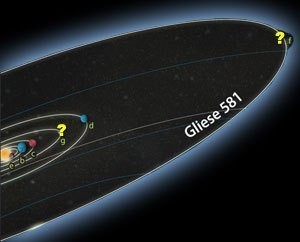With so many exoplanets being discovered, we have enough that we can start looking at the statistics of their various properties. Usually these deal with things such as their mass or habitability, but we’re also starting to look at the composition of their atmospheres. What we’re finding is that they share some common properties, but also hold a few mysteries.
Only a few exoplanets can be observed directly, so we usually have to rely on indirect methods. This typically involves observing the spectra of starlight as an exoplanet passes in front of it. While the planet blocks a small amount of the star’s light, making the star appear dimmer, any atmosphere of the planet absorbs only some of the starlight. By studying which wavelengths of light the atmosphere blocks, we can determine what wavelengths might be scattered or absorbed by the atmosphere. From this we can determine certain properties of the atmosphere.
For example, if shorter blue wavelengths are blocked more than longer red wavelengths, it could indicate Rayleigh scattering in the atmosphere, meaning that it could have a blue sky like Earth (or Pluto). If wavelengths are more uniformly blocked, it could indicate the presence of clouds. But one of the more interesting things to look at is just how different wavelengths are absorbed as the exoplanet just begins to pass in front of the star, or just as its ending its transit. From this we can determine how a planet’s atmosphere absorbs light at varying depths (what’s known as the depth function). Previous work has used an exoplanet’s depth function to determine its mass, for example. Depth functions are important because different types of atmospheres have different depth functions.
Recently a team made transit observations of 15 exoplanets at visible and near ultraviolet wavelengths. They found 10 of the planets had fairly uniform absorption, implying the presence of clouds, and 2 had evidence of Rayleigh scattering. When they looked at the depth functions of these exoplanets, they found that two of the worlds had depth functions that were…odd.
Typically an atmosphere absorbs more ultraviolet light than visible light. Our own atmosphere, for example, does this, which helps protect us against harmful ultraviolet rays. It’s generally what we’d expect, since ultraviolet light tends to scatter more when interacting with molecules. But in the case of these two exoplanets, they found that visible light was blocked or absorbed more than ultraviolet. What makes it more strange is that both of these exoplanets (WASP-1b and WASP-36b) are “hot Jupiters.” They have more mass than Jupiter and orbit their respective stars in a matter of days. It’s thought that such massive worlds should have atmospheres dominated by hydrogen and helium. If that were the case, they should block more ultraviolet than visible, since that’s what hydrogen/helium atmospheres do. So we aren’t sure what’s going on here.
Hot Jupiters were a bit of a surprise when they were first discovered. Now we know even their atmospheres can hold a few surprises.
Paper: Jake D. Turner, et al. Ground-based near-UV observations of 15 transiting exoplanets: Constraints on their atmospheres and no evidence for asymmetrical transits. MNRAS
doi: 10.1093/mnras/stw574 (2016)












